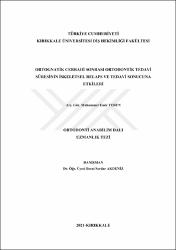| dc.contributor.advisor | BERAT SERDAR AKDENİZ | |
| dc.contributor.author | MUHAMMET EMİR TOSUN | |
| dc.date.accessioned | 2022-01-11T11:01:55Z | |
| dc.date.available | 2022-01-11T11:01:55Z | |
| dc.date.issued | 2021 | en_US |
| dc.identifier.uri | https://hdl.handle.net/20.500.12587/18076 | |
| dc.description.abstract | Giriş: Ortognatik cerrahinin ana hedefi, çeneler arası uyuşmazlığın giderilmesinin yanında bu sonuçların uzun dönem stabilitesinin de sağlanmasıdır. Tedavi sonucunda elde edilen iskeletsel ve dişsel ilişkilerde meydana gelen beklenmeyen değişiklikler 'relaps' olarak isimlendirilmektedir ve ortognatik cerrahinin komplikasyonlarından birisidir. Bu retrospektif çalışmada, ortognatik cerrahi girişimlerle tedavi edilen iskeletsel sınıf III bozukluğa sahip bireylerde cerrahi sonrası ortodontik tedavi sürecinin iskeletsel relaps ve stabilite üzerine etkileri değerlendirilmiştir. Yöntem: Çalışmamızın materyalini Kırıkkale Üniversitesi Diş Hekimliği Fakültesi Ortodonti Anabilim Dalı'nda 2014-2020 yılları arasında ortognatik cerrahi girişimlerle tedavi görmüş iskeletsel sınıf III bozukluğa sahip 32 hasta arasından seçilen dahil edilme kriterlerini karşılayan 20 hastanın lateral sefalometrik radyografileri oluşturmaktadır. Hastalar; cerrahi sonrası ortodontik tedavi süresi 6 aydan kısa olan (A) ve cerrahi sonrası ortodontik tedavi süresi 6 ay ve daha uzun olan (B) olmak üzere iki gruba ayrılmıştır. Çalışmada hastalardan ortodontik tedavi öncesi (T0), ortognatik cerrahi öncesi (T1), ortodontik tedavinin bitişi (T2) ve ortodontik tedavinin bitişinden 6 ay sonra takip muayenesinde(T3) alınan lateral sefalometrik radyografiler kullanılmıştır. Ortognatik cerrahi sonrası ortodontik tedavi süresi ile relaps arasında istatistiksel bir ilişki olup olmadığı değerlendirilmiştir. Bulgular: Çalışmanın sonuçları değerlendirildiğinde üst çene için relaps görülse bile klinik olarak anlamlı düzeyin (2mm veya 2o) altında kalmıştır. Takip muayenesi sonuçları incelendiğinde SNA, A-N perp ve Pg-N perp parametreleri için istatistiksel olarak anlamlı relaps görülmüştür. A ve B gruplarının relaps ortalamaları incelendiğinde iskeletsel ve dişsel parametrelerde istatistiksel olarak anlamlı bir fark bulunamamıştır. Sonuç: Çalışmamızın sonuçlarına göre relaps açısından kritik olarak değerlendirilen cerrahi sonrası ilk 6 aylık zaman dilimi içerisinde ortodontik tedavinin sonlandırılmasının stabilite üzerinde anlamlı bir değişikliğe neden olmadığı sonucuna ulaşılmıştır. Ortognatik cerrahi sonrası ortodontik tedavi kararlı bir kapanış ilişkisi sağlandığı anda bitirilebilir. Cerrahi planlamada özellikle üst çene hareketinin anlamlı derecede oluşan relaps göz önünde bulundurularak planlanması gerekmektedir. Anahtar Sözcükler: Ortodonti, sınıf III bozukluk, ortognatik cerrahi, cerrahi sonrası ortodonti, relaps | en_US |
| dc.description.abstract | Introduction: The main goal of orthognathic surgery is to eliminate the incompatibility between the jaws, as well as to ensure the long-term stability of these results. Unexpected changes in skeletal and dental relationships obtained as a result of treatment are called "relapses" and are one of the complications of orthognathic surgery. In this retrospective study, the effects of post-surgical orthodontic treatment process on skeletal relapse and stability in individuals with skeletal class III disorder treated with orthognathic surgical treatment were evaluated. Method: The material of our study consists of lateral cephalometric radiographs of 20 patients who met the inclusion criteria among 32 patients with skeletal class III disorder who were treated with orthognathic surgery between 2014-2020 in Kırıkkale University Faculty of Dentistry Department of Orthodontics. Patients included in the study; post-surgery orthodontic treatment duration is less than 6 months (A) and postoperative orthodontic treatment duration is 6 months and longer (B). Lateral cephalometric radiographs taken from the patients before orthodontic treatment (T0), before orthognathic surgery (T1), the end of orthodontic treatment (T2) and at the follow-up examination (T3) 6 months after the end of orthodontic treatment were used in the study. After orthognathic surgery, it was evaluated whether there was a statistical relationship between the duration of orthodontic treatment and relapse. Results: When the results of the study were evaluated, even if relapse was observed for the upper jaw, it remained below the clinically significant level (2mm or 2o). When the follow-up examination results were examined, a statistically significant relapse was observed for SNA, A-N perp and Pg-N perp parameters. When the average relapse of group A and group B were examined, no statistically significant difference was found in skeletal and dental parameters. Conclusion: According to the results of our study, it was concluded that termination of orthodontic treatment within the first 6 months after surgery, which was considered critical for relapse, did not cause a significant change on stability. After orthognathic surgery, orthodontic treatment can be completed as soon as a stable occlusal relationship is achieved. In surgical planning, especially upper jaw movement should be planned considering the relapse that occurs significantly. Keywords: Orthodontics, class III malocclusion, orthognathic surgery, postoperative orthodontics, relapse | en_US |
| dc.language.iso | tur | en_US |
| dc.rights | info:eu-repo/semantics/openAccess | en_US |
| dc.subject | Diş Hekimliği = Dentistry | en_US |
| dc.title | Ortognatik cerrahi sonrası ortodontik tedavi süresinin iskeletsel relaps ve tedavi sonucuna etkileri / | en_US |
| dc.title.alternative | The effects of the duration of orthodontic treatment after orthognatic surgery on skeletal relaps and treatment result | en_US |
| dc.type | specialtyThesis | en_US |
| dc.contributor.department | Kırıkkale Üniversitesi, Diş Hekimliği Fakültesi, Klinik Bilimler Bölümü | en_US |
| dc.relation.publicationcategory | Tez | en_US |
















